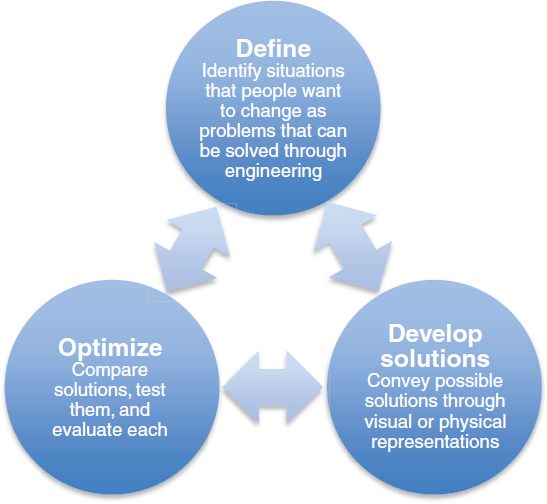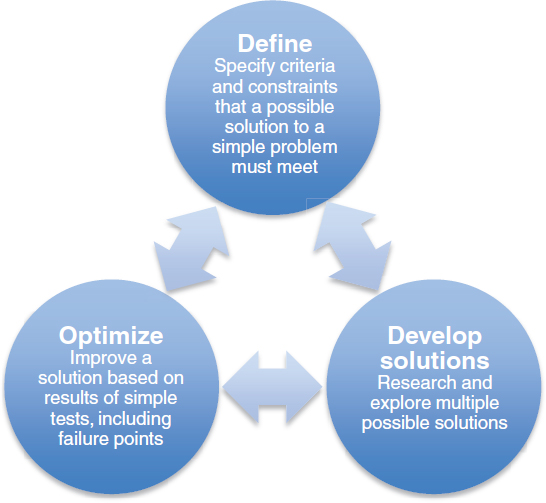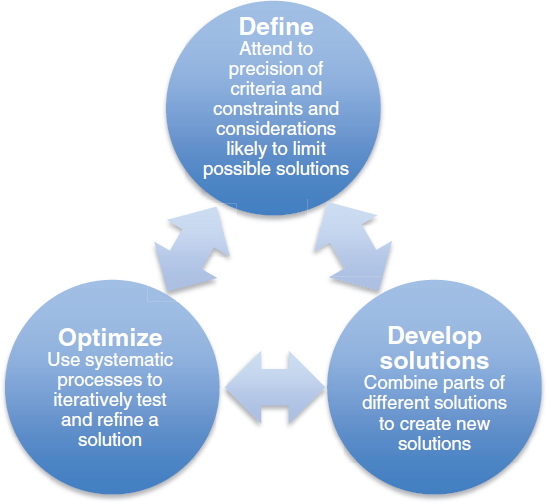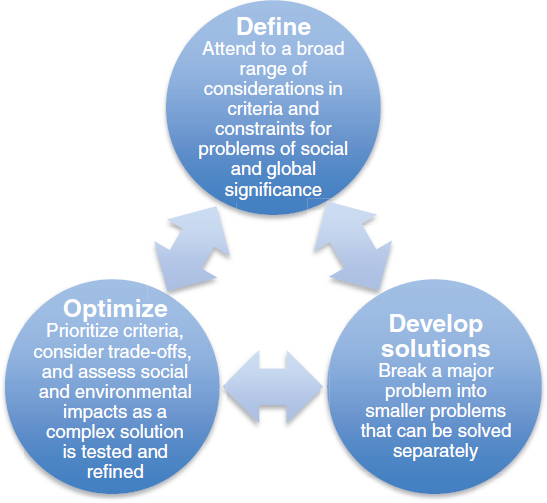APPENDIX I
ENGINEERING DESIGN IN THE NEXT GENERATION SCIENCE STANDARDS
The Next Generation Science Standards (NGSS) represent a commitment to integrate engineering design into the structure of science education by raising engineering design to the same level as scientific inquiry when teaching science disciplines at all levels, from kindergarten to twelfth grade. There are both practical and inspirational reasons for including engineering design as an essential element of science education.
We anticipate that the insights gained and interests provoked from studying and engaging in the practices of science and engineering during their K–12 schooling should help students see how science and engineering are instrumental in addressing major challenges that confront society today, such as generating sufficient energy, preventing and treating diseases, maintaining supplies of clean water and food, and solving the problems of global environmental change. (NRC, 2012, p. 9)
Providing students a foundation in engineering design allows them to better engage in and aspire to solve the major societal and environmental challenges they will face in the decades ahead.
KEY DEFINITIONS
One of the problems of prior standards has been the lack of clear and consistent definitions of the terms “science,” “engineering,” and “technology.” A Framework for K–12 Science Education (Framework) defines these terms as follows:
In the K–12 context, “science” is generally taken to mean the traditional natural sciences: physics, chemistry, biology, and (more recently) earth, space, and environmental sciences.... We use the term “engineering” in a very broad sense to mean any engagement in a systematic practice of design to achieve solutions to particular human problems. Likewise, we broadly use the term “technology” to include all types of human-made systems and processes—not in the limited sense often used in schools that equates technology with modern computational and communications devices. Technologies result when engineers apply their understanding of the natural world and of human behavior to design ways to satisfy human needs and wants. (NRC, 2012, pp. 11–12)
The Framework’s definitions address two common misconceptions. The first is that engineering design is not just applied science. As described in Appendix F: Science and Engineering Practices in the Next Generation Science Standards, the practices of engineering have much in common with the practices of science, although engineering design has a different purpose and product than scientific inquiry. The second misconception is that technology describes all the ways that people have modified the natural world to meet their needs and wants. Technology does not refer to just computers or electronic devices.
The purpose of defining “engineering” more broadly in the Framework and the NGSS is to emphasize engineering design practices that all citizens should learn. For example, students are expected to be able to define problems—situations that people wish to change—by specifying criteria and constraints for acceptable solutions, generating and evaluating multiple solutions, building and testing prototypes, and optimizing a solution. These practices have not been explicitly included in science standards until now.
ENGINEERING DESIGN IN THE FRAMEWORK
The term “engineering design” has replaced the older term “technological design,” consistent with the definition of engineering as a systematic practice for solving problems, and technology as the result of that practice. According to the Framework: “From a teaching and learning point of view, it is the iterative cycle of design that offers the greatest potential for applying science knowledge in the classroom and engaging in engineering practices” (NRC, 2012, pp. 201–202). The Framework recommends that
students explicitly learn how to engage in engineering design practices to solve problems.
The Framework also projects a vision of engineering design in the science curriculum and of what students can accomplish from early school years to high school:
In some ways, children are natural engineers. They spontaneously build sand castles, dollhouses, and hamster enclosures, and they use a variety of tools and materials for their own playful purposes.... Children’s capabilities to design structures can then be enhanced by having them pay attention to points of failure and asking them to create and test redesigns of the bridge so that it is stronger. (NRC, 2012, p. 70)
By the time these students leave high school, they can “undertake more complex engineering design projects related to major global, national, or local issues” (NRC, 2012, p. 71). The core idea of engineering design includes three component ideas:
- Defining and delimiting engineering problems involves stating the problem to be solved as clearly as possible in terms of criteria for success and constraints or limits.
- Designing solutions to engineering problems begins with generating a number of different possible solutions, then evaluating potential solutions to see which ones best meet the criteria and constraints of the problem.
- Optimizing the design solution involves a process in which solutions are systematically tested and refined and the final design is improved by trading off less important features for those that are more important.
It is important to point out that these component ideas do not always follow in order, any more than do the “steps” of scientific inquiry. At any stage, a problem solver can redefine the problem or generate new solutions to replace an idea that is just not working out.
ENGINEERING DESIGN IN RELATION TO STUDENT DIVERSITY
The NGSS inclusion of engineering with science has major implications for non-dominant student groups. From a pedagogical perspective, the focus on engineering is inclusive of students who may have traditionally been marginalized in the science classroom or experienced science as not being relevant to their lives or future. By asking questions and solving meaningful problems through engineering in local contexts (e.g., watershed planning, medical equipment, instruments for communication for the deaf), diverse students deepen their science knowledge, come to view science as relevant to their lives and future, and engage in science in socially relevant and transformative ways.
From a global perspective, engineering offers opportunities for “innovation” and “creativity” at the K–12 level. Engineering is a field that is critical to undertaking the world’s challenges, and exposure to engineering activities (e.g., robotics and invention competitions) can spark interest in the study of science, technology, engineering, and mathematics and future careers (NSF, 2010). This early engagement is particularly important for students who have traditionally not considered science as a possible career choice, including females and students from multiple languages and cultures.
ENGINEERING DESIGN IN THE NEXT GENERATION SCIENCE STANDARDS
In the NGSS, engineering design is integrated throughout the document. First, a fair number of standards in the three disciplinary areas of life, physical, and earth and space sciences begin with an engineering practice. In these standards, students demonstrate their understanding of science through the application of engineering practices. Second, the NGSS also include separate standards for engineering design at the K–2, 3–5, 6–8, and 9–12 grade levels. This multi-pronged approach, including engineering design both as a set of practices and as a set of core ideas, is consistent with the original intention of the Framework.
It is important to point out that the NGSS do not put forward a full set of standards for engineering education, but rather include only practices and ideas about engineering design that are considered necessary for literate citizens. The standards for engineering design reflect the three component ideas of the Framework and progress at each grade span.

GRADES K–2
Engineering design in the earliest grades introduces students to “problems” as situations that people want to change. They can use tools and materials to solve simple problems, use different representations to convey solutions, and compare different solutions to a problem and determine which is best. Students in all grade levels are not expected to come up with original solutions, although original solutions are always welcome. Emphasis is on thinking through the needs or goals that need to be met and on which solutions best meet those needs and goals.

GRADES 3–5
At the upper elementary grades, engineering design engages students in more formalized problem solving. Students define a problem using criteria for success and constraints or limits of possible solutions. Students research and consider multiple possible solutions to a given problem. Generating and testing solutions also becomes more rigorous as students learn to optimize solutions by revising them several times to obtain the best possible design.

GRADES 6–8
At the middle school level, students learn to sharpen the focus of problems by precisely specifying criteria and constraints of successful solutions, taking into account not only what needs the problem is intended to meet, but also the larger context within which the problem is defined, including limits to possible solutions. Students can identify elements of different solutions and combine them to create new solutions. Students at this level are expected to use systematic methods to compare different solutions to see which best meet criteria and constraints, and to test and revise solutions a number of times in order to arrive at an optimal design.

GRADES 9–12
Engineering design at the high school level engages students in complex problems that include issues of social and global significance. Such problems need to be broken down into simpler problems to be tackled one at a time. Students are also expected to quantify criteria and constraints so that it will be possible to use quantitative methods to compare the potential of different solutions. While creativity in solving problems is valued, emphasis is on identifying the best solution to a problem, which often involves researching how others have solved it before. Students are expected to use mathematics and/or computer simulations to test solutions under different conditions, prioritize criteria, consider tradeoffs, and assess social and environmental impacts.
CONCLUSION
The inclusion of engineering design within the fabric of the NGSS has profound implications for curriculum, teaching, and assessment. All students need opportunities to acquire engineering design practices and concepts alongside the practices and concepts of science.
The decision to integrate engineering design into the science disciplines is not intended either to encourage or discourage development of engineering courses. In recent years, many middle and high schools have introduced engineering courses that build students’ engineering skill, engage them in experiences using a variety of technologies, and provide information on a range of engineering careers. The engineering design standards included in the NGSS could certainly be a component of such courses but most likely do not represent the full scope of such courses or an engineering pathway. Rather, the purpose of the NGSS is to emphasize the key knowledge and skills that all students need in order to engage fully as workers, consumers, and citizens in 21st-century society.
Performance Expectations That Incorporate Engineering Practices
| Grade | Physical Sciences | Life Sciences | Earth and Space Sciences | Engineering |
|---|---|---|---|---|
| K | K-PS2-2 K-PS3-2 |
K-ESS3-2 K-ESS3-3 |
K-2-ETS1-1 K-2-ETS1-2 K-2-ETS1-3 |
|
| 1 | 1-PS4-4 | 1-LS1-1 | ||
| 2 | 2-PS1-2 | 2-LS2-2 | 2-ESS2-1 | |
| 3 | 3-PS2-4 | 3-LS4-4 | 3-ESS3-1 | 3-5-ETS1-1 3-5-ETS1-2 3-5-ETS1-3 |
| 4 | 4-PS3-4 4-PS4-3 |
4-ESS3-2 | ||
| 5 | ||||
| 6–8 | MS-PS1-6 MS-PS2-1 MS-PS3-3 |
MS-LS2-5 | MS-ETS1-1 MS-ETS1-2 MS-ETS1-3 MS-ETS1-4 |
|
| 9–12 | HS-PS1-6 HS-PS2-3 HS-PS2-6 HS-PS3-3 HS-PS4-5 |
HS-LS2-7 HS-LS4-6 |
HS-ESS3-2 HS-ESS3-4 |
HS-ETS1-1 HS-ETS1-2 HS-ETS1-3 HS-ETS1-4 |
REFERENCES
NRC (National Research Council). (2012). A framework for K–12 science education: Practices, crosscutting concepts, and core ideas. Washington, DC: The National Academies Press.
NSF (National Science Foundation). (2010). Preparing the next generation of STEM innovators: Identifying and developing our nation’s human capital. Washington, DC: NSF.





